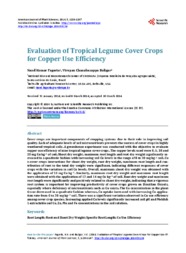Evaluation of tropical legume cover crops for copper use efficiency.
Evaluation of tropical legume cover crops for copper use efficiency.
Autoria: FAGERIA, N. K.; BALIGAR, V. C.
Resumo: Cover crops are important components of cropping systems due to their role in improving soil quality. Lack of adequate levels of soil micronutrients prevents the success of cover crops in highly weathered tropical soils. A greenhouse experiment was conducted with the objective to evaluate copper use efficiency of nine tropical legume cover crops. The copper levels used were 0, 5, 10 and 20 mg Cu kg−1 of soil. Shoot dry weight, maximum root length and root dry weight significantly increased in a quadratic fashion with increasing soil Cu levels in the range of 0 to 20 mg kg−1 soil. Cu x cover crops interactions for shoot dry weight, root dry weight, maximum root length and contribution of root to the total dry weight were significant, indicating different responses of cover crops with the variation in soil Cu levels. Overall, maximum shoot dry weight was obtained with the application of 13 mg Cu kg−1. Similarly, maximum root dry weight and maximum root length were obtained with the application of 12 and 14 mg Cu kg−1 of soil. Root dry weight and maximum root length were significantly and positively related to shoot dry weight, indicating that a vigorous root system is important for improving productivity of cover crops grown on Brazilian Oxisols, especially where deficiency of micronutrients such as Cu exists. The Cu concentration in the plant tissue decreased in a quadratic fashion whereas, Cu uptake increased with increasing Cu application rate from 0 to 20 mg kg−1 soil. There was a significant variation observed in Cu use efficiency among cover crop species. Increasing applied Cu levels significantly increased soil pH and Mehlich 1 extractable soil Cu, Zn, Mn and Fe concentrations in the soil solution.
Ano de publicação: 2014
Tipo de publicação: Artigo de periódico
Unidade: Embrapa Arroz e Feijão
Palavras-chave: Cobertura vegetal, Cobre, Cover crops, Fertilizante fosfatado, Microelemento, Plant micronutrients, Raíz, Root growth
Observações
1 - Por padrão são exibidas publicações dos últimos 20 anos. Para encontrar publicações mais antigas, configure o filtro ano de publicação, colocando o ano a partir do qual você deseja encontrar publicações. O filtro está na coluna da esquerda na busca acima.
2 - Para ler algumas publicações da Embrapa (apenas as que estão em formato ePub), é necessário ter, no celular ou computador, um desses softwares gratuitos. Sistemas Android: Google Play Livros; IOS: iBooks; Windows e Linux: software Calibre.
Acesse outras publicações
Acesse a Base de Dados da Pesquisa Agropecuária (BDPA) para consultar o acervo completo das bibliotecas da Embrapa.

